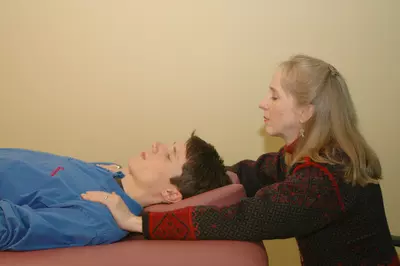Reiki

How Does Reiki Work?
At the simplest, most obvious level, it appears that Reiki treatment helps lessen the impact of stress, releasing tension from the entire system. Not only does the person move toward his or her own unique balance in body, mind and spirit, but also, depending on the level of physical health when Reiki begins, the body's own healing mechanisms often begin functioning more effectively.
What is Reiki doing?
 How exactly does Reiki release tension and help the body heal? That question has yet to be answered. Although there is increasing research evidence documenting the effects of Reiki (such as lowered heart rate, blood pressure, and stress hormones; increased immune strength), we have only broad theories as to what causes these effects or the pathways through which the healing occurs.
How exactly does Reiki release tension and help the body heal? That question has yet to be answered. Although there is increasing research evidence documenting the effects of Reiki (such as lowered heart rate, blood pressure, and stress hormones; increased immune strength), we have only broad theories as to what causes these effects or the pathways through which the healing occurs.
The multileveled, rapid response to Reiki suggests a complex process that engages many body systems, simultaneously or in quick succession, shifting the body from domination by the "fight or flight" (stress) response to the relaxation response, and supporting the body's own healing mechanisms. (For more information about the relaxation response, see the Mind-Body Therapies section.) Some researchers theorize that Reiki's physical, mental, emotional, and spiritual healing effect is triggered on a subphysical level, perhaps in what science refers to as the biofield.
What is the biofield?
The biofield is the term medical science has adopted for the intricately layered vibrational energy field that is said to surround and penetrate the physical body. The biofield is extremely subtle and there is as yet no conventional scientific technology that can document its existence or otherwise study it directly. However, for thousands of years, traditional, indigenous, prescientific medical systems have recognized a balanced, evenly pulsing biofield as the foundation of health and wellbeing, and seen any disruption of this balance as the beginning of illness.

The healing traditions of indigenous cultures around the world use vibration to restore balance through ceremonial drumming, through instruments such as the didgeridoo and the tamboura, and through chanting, overtoning, and humming. Moreover, the therapeutic value of vibration in the forms of sound and music is increasingly supported by science. Perhaps Reiki's benefits occur through the same vibrational mechanism, a process which likely involves increasing coherence and decreasing dissonance in the system.
One theory is that the Reiki practitioner's hands carry the energetic vibrations of the recipient's wellness. The effect of Reiki could be seen as a shift in attention in which the recipient becomes aware of the wellness that exists deep within his or her being regardless the current level of health. Reiki could then be understood as entraining the recipient back to health in a process similar to the way grandfather clocks in the same room self-adjust to the rhythm of the dominant clock, or in the way we relax when in the presence of someone who is deeply peaceful. Reiki seems to connect the practitioner with an inner source of peace no matter how he or she feels in the moment.
Many therapies aim to restore balance in the biofield-acupuncture, qigong, shiatsu, and yoga/pranayama to name a few. Reiki appears to be the subtlest of these therapies, balancing the recipient through subtle Reiki vibrations rather than through manipulation or even the gentlest force. It is also possible that Reiki, which some practitioners consider more akin to meditation than to energy therapies, does not originate in the biofield, but rather arises from an even subtler source: what physicists have termed the unified field.
How does Reiki relate to other integrative therapies?
The National Center for Complementary and Integrative Health (NCCIH) describes Reiki as a complementary and alternative medicine practice that uses putative (yet to be measured) energy fields, or biofields, to affect health. Energy biofield therapies "generally reflect the concept that human beings are infused with subtle forms of energy," which are believe to surround and interpenetrate human form. Energy therapies, such as therapeutic touch and Healing Touch, are believed to balance these subtle energy fields.
Some Reiki practitioners find that Reiki is different from other energy therapies and is actually closer to meditation. For example, while most energy therapies use techniques to assess the recipient's biofield and make specific corrections, Reiki practitioners do not diagnose and do not deliberately reorganize the biofield.
Reiki practice is extremely passive. The Reiki practitioner's hands are still for most of the treatment, moving only to change hand placements. The Reiki practitioner is neutral, making no attempt to fix the recipient or to change the biofield. Additionally, the practitioner does not in any way control Reiki energy; she/he merely rests her hands lightly on the body (or just above the body if needed, for example, in the presence of an open wound or burn).
Reiki energy in the practitioner's hands arises spontaneously in response to the individual recipient's need for balance at that particular time. In this way, each Reiki treatment is automatically customized to the immediate need of that particular recipient, even though the practitioner may use the same sequence of hand placements for each treatment.
Reiki is optimally given in a full treatment format but can also be administered in abbreviated treatments to a specific area or areas of the body. In urgent situations, even moments of Reiki touch can be soothing.
Becker, RO. (1990). Cross Currents: The promise of electromedicine, the perils of electropollution. Los Angeles, CA: Tarcher.
Becker, RO. Selden, G. (1998). The Body Electric: Electromagnetism and the Foundation of Life. New York, NY: Harper.
Gaynor, ML. (1999). Sounds of Healing. New York, NY: Broadway Books.
Gerber, R. (2001). A Practical Guide to Vibrational Medicine: Energy Healing and Spiritual Transformation. William Morrow Paperbacks.
Gerber, R. (1996). Vibrational Medicine: New Choices for Healing Ourselves. Rochester, VT: Bear & Co.
Goldman, J. (1992). Healing Sounds. Rochester, VT: Healing Arts Press.
Horrigan, B. (2003). Reiki Vibrational Healing. Alternative Therapies in Health and Medicine. 9(4), 74-83.
McEwen, B., Lasley, EN. (2004). The End of Stress As We Know It. New York, NY: The Dana Press.
Moyers, B. (1993). Healing and the Mind. New York, NY: Broadway Books.
National Center for Complementary and Integrative Health (NCCIH). (2012). Reiki: What you need to know. Retrieved August 17, 2015, from https://nccih.nih.gov/health/reiki/introduction.htm
Takata, H. First Person: Mrs. Takata Tells her Story: Cause and Effect. Reiki Magazine International, 3(1), 8.

